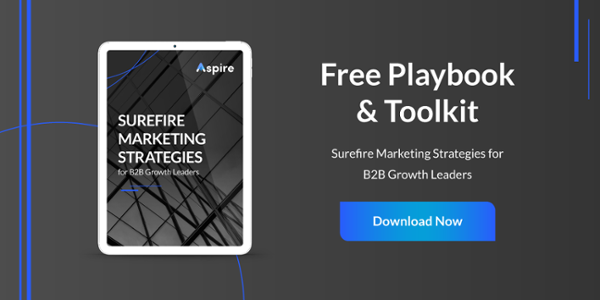- Marketing Strategy
- Lead Generation
- PPC
- April 1, 2023
LinkedIn Ads vs. Google Ads: Which Platform Should Your B2B Organization Use?

Cameron Beltran

A recent report found 80% of marketers agree marketing has changed more in the last three years than in the last fifty! What does this mean for B2B businesses? Ultimately, it means you can’t just keep doing things the same way you used to. To stand out and meet your buyers’ needs, you have to adapt your approach.
One key component to this is investing in digital advertising, also known as Pay per Click (or “PPC”). While many businesses advertise online – few do it well. It’s particularly hard when businesses have a slew of options at their disposal. Should you invest in LinkedIn Ads? Google Ads? Both? What are the differences between these platforms, and when should you use them?
Whether you already have digital ads in place or no digital ad experience at all, this guide will help you assess both platforms so you can choose the best one.
It’s easy to get caught up in the nuances of each advertising platform, that’s why we put together this in-depth guide comparing these two highly popular platforms for B2B businesses.
We’ll walk you through the types of ads each platform offers as well as the capabilities of their audience targeting features and what you can expect in terms of cost. To help set you up for success, we’ll also discuss which platform is best for each stage of your customer’s journey.
1. Ad Types
Both Google Ads and LinkedIn Ads offer a robust selection of ad types as well as a network of websites and platforms to serve your ads on. If you’re new to digital advertising, here are some of the ad types we recommend starting with for each platform:
- Search Ads - the most common Google Ad format. These ads appear on the search results pages when a user searches for a keyword that matches your ad. This means if you’ve done your keyword research right, it’s most likely being viewed by someone who is in-market for products or services like yours –and more likely to turn into a lead.
- Display Ads - they appear on the many websites that are part of the Google Display Network. This ad type is great for building brand awareness or retargeting leads who have already interacted with previous ads or viewed your website.
- Single-Image Ads - one of the best performing ad types available and simple to set up. They appear directly in the News Feed.
- Text Ads - they have the least amount of risk as the most affordable out of all the LinkedIn Ad types. They also appear directly in the News Feed.
Winner: 🤝 Tie (Depends on Your Needs)
2. Audience Targeting
With LinkedIn Ads, you’re able to target very specific audiences – this is arguably the strongest benefit of using this advertising platform. You even have the power to specifically go after decision makers – with four out of five LinkedIn members having the power to directly impact business decisions.
The Company Match targeting can be especially fruitful for B2B businesses using Account Based Marketing (ABM). You can upload lists of companies you’d like to target and LinkedIn will serve your ads to employees of those companies. Filtering which employees see these ads by seniority or job title is also possible. This highly specific audience targeting can have a tremendous impact on your digital marketing.
While LinkedIn Ads has more specific audience targeting, Google Ads does have a larger overall audience reach with 97,105 Google searches per second. Not to say Google Ads doesn’t offer precise targeting – it does, though takes time to optimize – but given LinkedIn’s business focus, it has enormous data about prospects. Information like their employer, the size of their employer, their background and job history, their seniority, and more – this is information LinkedIn is privvy to that Google is often not.
Winner: 🥇 LinkedIn Ads
3. Cost
The cost of LinkedIn Ads can be one of the heavier cons of this platform. If you do not have a monthly budget of at least $2,000 and a high lifetime value for your services or product – creating a profitable LinkedIn Ads campaign can be extremely difficult. Without this kind of budget, you’ll likely find yourself without enough statistically significant data to make informed decisions. It’s also important to keep in mind, the cost of LinkedIn ad campaigns varies a considerable amount depending on your campaign objective and ad type.
Depending on the competition within your industry, Google Ads are often considerably more affordable than LinkedIn Ads. Though the Cost Per Click (CPC) for Google Ads can range anywhere from a few cents to a few hundred dollars – this is usually proportional to the cost of your services or product.
Winner: 🥇 Google Ads
4. Ease of Use
Google makes it easier to get started on their ads platform. Google Ads’ Smart and Performance Max Campaigns use Google’s powerful automation technology to save you time and resources. These campaigns are often not the most optimized, but their setup can take as little as 15 minutes.
On LinkedIn, there are much more limited options for quickly launching ads like this. Key components of ads, like audience targeting, require you to do manual work. This is complicated by the fact that many of LinkedIn’s own recommendations often don’t pan out. For example, LinkedIn encourages you to check the “Audience Expansion” box, but we’ve found that this takes the targeting control out of your hands and almost always delivers subpar results.
However, Google Ads automated campaigns often don’t perform the best. For many organizations, having more control over your campaigns by creating them from scratch can increase performance. And that’s where things can get complex. Getting started with Google Ads is easy, but the Google Ads platform is incredibly complex. This is great if you know the system well, but can be overwhelming for newer users. Whereas, LinkedIn’s Campaign Manager has a lot less ‘bells and whistles’ that can make a custom ad campaign easier to operationalize.
At the end of the day, both platforms have their quirks. Building simple ads on Google Ads can be efficient, but it can be a bit easier to get customized ads on LinkedIn. At the end of the day, an expert partner may be able to help you get the most out of either platform.
Winner: Tie
When to Use LinkedIn Ads vs. Google Ads
If your budget allows you to invest in LinkedIn Ads, we find LinkedIn most useful for adding leads to your funnel, warming them, and moving them down your funnel. As great as this platform is for finding leads that fit your Ideal Customer Profile, it’s nearly impossible to predict whether those leads are “in market” for your services. With this in mind, some effective campaigns you could run on LinkedIn include:
- Sharing blog posts and articles that are educational, to build trust with your audience
- Sharing eBooks or other educational downloadables, to generate leads
- Retargeting those who engage with your ads, to keep your brand top-of-mind
On the other hand, Google Ads is an especially great platform for B2B businesses that want to focus on the bottom of their funnel and target in-market users who are actively searching for solutions to their business problems. Considering the amount of Google searches every day, these ads can be enormously impactful.
It’s also extremely important to note, these ad platforms do not have to work in silos. You can take advantage of both and create a thorough full funnel strategy for your digital advertising. With LinkedIn Ads targeting top and middle of the funnel prospects and Google Ads primarily focused on bottom of the funnel conversions – you can start to build a a fine tuned digital advertising machine.
LinkedIn Ads vs. Google Ads: Key Takeaways
Both LinkedIn Ads and Google Ads offer unique pros and cons for B2B organizations. The best PPC choice for your business ultimately depends on your goals, budget, and target audience. LinkedIn Ads excel in precise audience targeting and reaching decision-makers. Meanwhile, Google Ads boast more reach, are more likely to reach “in-market” buyers, and are often more affordable.
To get the most out of each, we recommend leveraging both platforms in a complementary manner. Use LinkedIn Ads to nurture top and middle-of-the-funnel prospects and Google Ads to capture bottom-of-the-funnel conversions. However, if your budget restricts you to only one platform, you now have the information you need to choose.
Remember, ads alone likely won't solve your business challenges. Your efforts may fall short if your website is not optimized for conversions or if you lack a comprehensive inbound marketing plan. A thoughtful marketing strategy is essential to make the most of your PPC budget.
Want to learn how you can get more out of your advertising and digital efforts? Consider Aspire’s marketing services for B2B organizations.



0 Comments